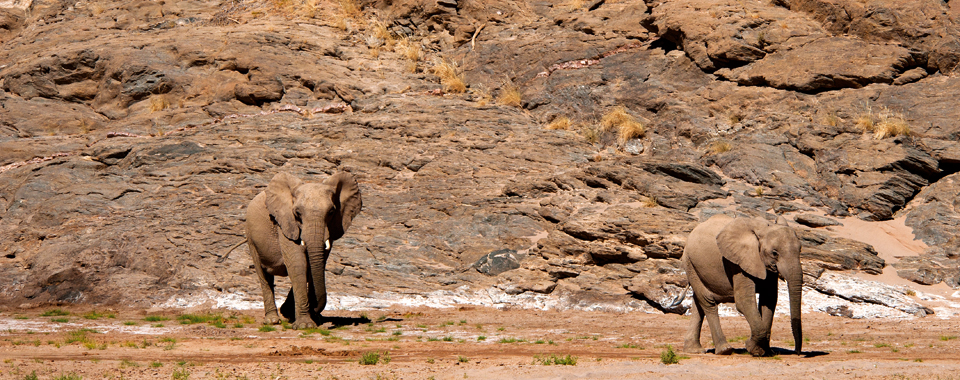Namibian angling – Cast your lure in the rapids
September 3, 2012Nature Notes – Abounding in body language
September 3, 2012by Charlene Cooke
It is fair to say that most people are awed by the gigantic size of the African elephant and humbled by its apparent calm demeanour. In remote parts of Namibia, these gentle giants have adapted to survive in harsh desert conditions.
Loxodonta africana africana occupy home ranges, rotating as the season changes through such ranges to where food and water can be found. Herds are led by a matriarch, who is usually the oldest female and has accumulated as much as 30 years’ experience of the climatic conditions in her home range.
In the Kaokoveld, elephants work extremely hard, trekking for long distances when food and water become scarce. It has been recorded that elephant home ranges in this region cover up to 3 000 km2, with the animals trekking up to 200 km in search of water.
Elephants have to feed more than 14 hours a day to nourish their enormous bodies. They browse continuously and eat specific plants for nutritional minerals and vitamins. It is therefore no wonder that they nap standing up for only a few minutes at a stretch.
The desert-dwelling elephants of the Kaokoveld eat plants that are found nowhere else in Africa. When feeding on the limited supply of food, they take far greater care than their relatives in the less arid Etosha National Park. They hardly ever fell trees, break fewer branches and debark much less than other elephants. If possible, an elephant goes to water once a day to drink.
On average an adult drinks about 100–200 litres of water a day. In the Kaokoveld, where water is scarce, an elephant will get to drink water only once every three to four days. When searching for water during droughts, elephant dig deep, narrow holes in dry riverbeds with their tusks, trunk and feet.
These huge pachyderms are peaceful animals, but become extremely aggressive when they are sick, injured or harassed, and especially when there are young calves in the herd. They learn to respond to threats as they grow up and as such they prefer to stay clear of humans.
Elephants communicate with all five senses, those of hearing and smell being especially acutely developed.
Groups communicate by trumpeting very loudly and with low-frequency vocalisations inaudible to the human ear, the sounds carrying over distances of 10 km.
Elephants have reasonable vision and rely a great deal on their heightened sense of smell and hearing to familiarise themselves with their surroundings.
In the Kaokoveld several west-flowing ephemeral rivers have carved their courses through rocks over thousands of years. It is in the far north east in the deep valleys of the Hoanib and Hoa-rusib rivers that the true desert-adapted elephant is found.
Dieter Risser of Ondjamba Safaris is an experienced safari guide who specialises in Desert Elephant safaris.
He has become increasingly alarmed by the large 4X4 convoys (more than 10 vehicles at a time) driving at relatively high speeds through the natural habitat of these elephants. “The huge dust clouds and high pitch of revved vehicle engines confuse and agitate the elephants, and represent danger signals to them,” he explains. “There is nowhere for the animals to go and they become stressed and aggressive.” Ceasar Zandberg of Kunene Tours & Safaris is equally concerned about the stressed elephants and acknowledges that it is a tough situation to manage.
“We have to create an awareness and educate the ignorant tourist on the habits of the animals,” he says. “Desert elephant can also be viewed in the Ugab, Huab and Aba-Huab river courses, so there is no reason for one area to be over-visited.”
According to Rob Braby of NACOMA, “Tourism is an industry that can destroy itself. Everybody wants to visit a pristine area, but if we don’t all take responsibility for our actions in these areas, they will not exist for very much longer.”
We appeal to visitors to be receptive to the dilemma of the desert-adapted elephant in their natural habitat and to act responsibly by observing the following:
• Avoid enclosed areas where the animals might feel trapped.
• Do not stop your vehicle in the middle of their migration path.
• Do not camp at waterholes; use nearby campsites instead.
• Let some of the air out of your tyres and put your vehicle into four-wheel drive. This will enable you to drive slowly and keep the engine noise down.
• Try to minimise the number of vehicles when you go on safari – in the process you’ll also keep costs down.
• Keep to existing roads and tracks, so as not to damage the area when driving through it. It is advisable not get out of your car when encountering an elephant herd.
• Do not feed and throw objects at the animals.
Keep in mind that as humans, we are trespassing in their territory.
This article appeared in the May/June ‘04 edition of Travel News Namibia.




